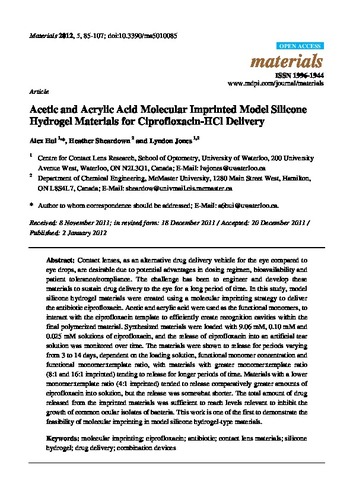| dc.contributor.author | Hui, Alex | |
| dc.contributor.author | Sheardown, Heather | |
| dc.contributor.author | Jones, Lyndon W. | |
| dc.date.accessioned | 2017-03-07 19:47:57 (GMT) | |
| dc.date.available | 2017-03-07 19:47:57 (GMT) | |
| dc.date.issued | 2012-01-02 | |
| dc.identifier.uri | http://dx.doi.org/10.3390/ma5010085 | |
| dc.identifier.uri | http://hdl.handle.net/10012/11461 | |
| dc.description | Hui, A., Sheardown, H., & Jones, L. (2012). Acetic and Acrylic Acid Molecular Imprinted Model Silicone Hydrogel Materials for Ciprofloxacin-HCl Delivery. Materials, 5(12), 85–107. https://doi.org/10.3390/ma5010085 | en |
| dc.description.abstract | Contact lenses, as an alternative drug delivery vehicle for the eye compared to eye drops, are desirable due to potential advantages in dosing regimen, bioavailability and patient tolerance/compliance. The challenge has been to engineer and develop these materials to sustain drug delivery to the eye for a long period of time. In this study, model silicone hydrogel materials were created using a molecular imprinting strategy to deliver the antibiotic ciprofloxacin. Acetic and acrylic acid were used as the functional monomers, to interact with the ciprofloxacin template to efficiently create recognition cavities within the final polymerized material. Synthesized materials were loaded with 9.06 mM, 0.10 mM and 0.025 mM solutions of ciprofloxacin, and the release of ciprofloxacin into an artificial tear solution was monitored over time. The materials were shown to release for periods varying from 3 to 14 days, dependent on the loading solution, functional monomer concentration and functional monomer:template ratio, with materials with greater monomer:template ratio (8:1 and 16:1 imprinted) tending to release for longer periods of time. Materials with a lower monomer:template ratio (4:1 imprinted) tended to release comparatively greater amounts of ciprofloxacin into solution, but the release was somewhat shorter. The total amount of drug released from the imprinted materials was sufficient to reach levels relevant to inhibit the growth of common ocular isolates of bacteria. This work is one of the first to demonstrate the feasibility of molecular imprinting in model silicone hydrogel-type materials. | en |
| dc.description.sponsorship | The authors would like to thank Lakshman Subbaraman for his help in making the materials and manuscript editing. AH is supported by the Natural Sciences and Engineering Research Council (NSERC) of Canada, the Canadian Optometric Education Trust Fund (COETF) and a Vistakon® Research Grant and Ezell Fellowship, both administered by the American Optometric Foundation (AOF). This study is also supported by the NSERC 20/20 Network for the Development of Advanced Ophthalmic Materials. | |
| dc.language.iso | en | en |
| dc.publisher | Multidisciplinary Digital Publishing Institute | en |
| dc.rights | Attribution 3.0 Unported | * |
| dc.rights.uri | https://creativecommons.org/licenses/by/3.0/ | * |
| dc.subject | Molecular imprinting | en |
| dc.subject | Ciprofloxacin | en |
| dc.subject | Antibiotic | en |
| dc.subject | Contact lens materials | en |
| dc.subject | Silicone hydrogel | en |
| dc.subject | Drug delivery | en |
| dc.subject | Combination devices | en |
| dc.title | Acetic and Acrylic Acid Molecular Imprinted Model Silicone Hydrogel Materials for Ciprofloxacin-HCl Delivery | en |
| dc.type | Article | en |
| dcterms.bibliographicCitation | Hui, A., Sheardown, H., & Jones, L. (2012). Acetic and Acrylic Acid Molecular Imprinted Model Silicone Hydrogel Materials for Ciprofloxacin-HCl Delivery. Materials, 5(12), 85–107. https://doi.org/10.3390/ma5010085 | en |
| uws.contributor.affiliation1 | Faculty of Science | en |
| uws.contributor.affiliation2 | School of Optometry and Vision Science | en |
| uws.typeOfResource | Text | en |
| uws.peerReviewStatus | Reviewed | en |
| uws.scholarLevel | Faculty | en |


